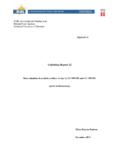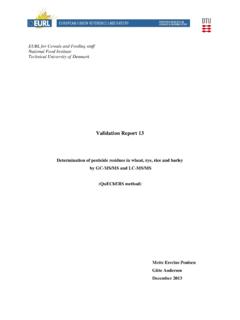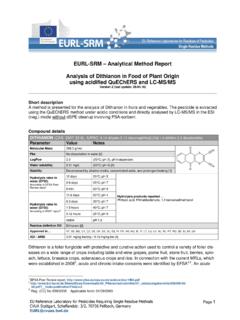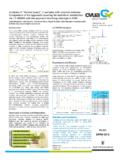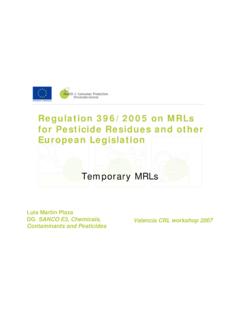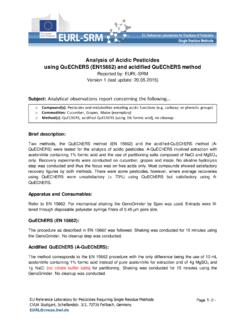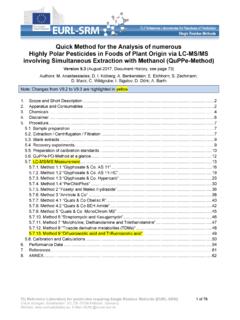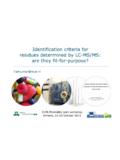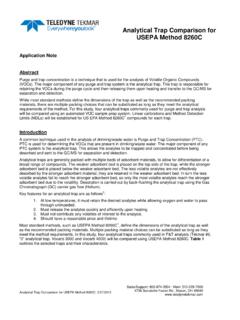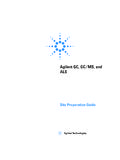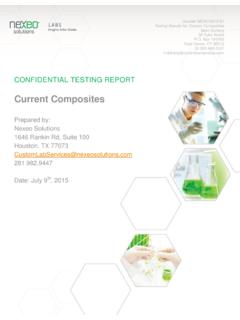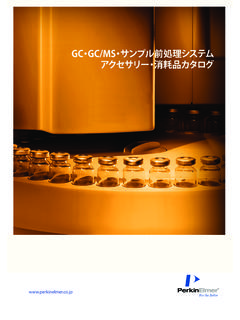Transcription of Determination of pesticide residues in avocado and almond ...
1 Page 1 Determination of pesticide residues in avocado and almond by liquid and gas chromatography tandem mass spectrometry Page 2 CONTENTS 1. Aim and scope .. 3 2. Short description .. 3 3. Apparatus and consumables .. 3 4. Chemicals .. 3 5. Procedure .. 4 Sample preparation .. 4 Recovery experiments for method validation .. 4 Extraction .. 4 avocado .. 4 almond .. 5 Measurement .. 6 Instrumentation and analytical conditions for the LC- MS/MS system .. 6 Agilent 1200 HPLC .. 6 Agilent 6490 QqQ MS/MS .. 7 Instrumentation and analytical conditions for the GC- MS/MS system .. 7 Agilent 7890 .. 7 Agilent 7000 QqQ MS/MS .. 8 6. Validation of the method .. 8 Recoveries and within-laboratory reproducibility .. 8 Limits of quantitation .. 8 Linearity .. 8 Matrix effects.
2 9 7. References .. 9 APPENDIX I: MASS TRANSITIONS .. 10 APPENDIX II: VALIDATION RESULTS .. 17 Page 3 1. Aim and scope This report describes a validation data of 279 pesticides using a multiresidue method by LC-MS/MS and GC-MS/MS in avocado and almond . 2. Short description An homogenous sample is extracted with acetonitrile according to modified QuEChERS protocol. The obtained extract is analysed by GC-MS/MS and LC-MS/MS. 3. Apparatus and consumables Automatic pipettes, suitable for handling volumes of 4 L to 500 L and 1 mL to 5 mL. 50 ml PTFE centrifuge tubes with screw caps 15 ml PTFE centrifuge tubes with screw caps Vortex Automatic axial extractor Centrifuge, suitable for the centrifuge tubes employed in the procedure and capable to achieve at least 3700 rpm Concentration workstation Syringes, 2 mL disposable syringes Syringe filters, m pore size Injection vials, 2 ml, suitable for LC and GC auto-sampler Volumetric flasks Z-Sep sorbent (Supelco) 4.
3 Chemicals Acetonitrile ultra gradient grade Formic acid Trisodium citrate dihydrate Sodium chloride Disodium hydrogencitrate sesquihydrate Anhydrous magnesium sulphate Ultra pure water Ethyl acetate HPLC grade pesticides standards Page 4 5. Procedure Sample preparation To obtain representative subsamples, samples should be frozen over night and after that minced. Before freezing, the stones of avocado should be eliminated. Recovery experiments for method validation The samples employed in the validation studies did not contain any of the analysed pesticides . Individual pesticide stock solutions (1000 2000 mg/L) were prepared in acetonitrile and ethyl acetate and were stored in amber screw-capped glass vials in the dark at -20 C. For spiking, - 70 g representative portions of previously homogenised avocado were weighed and transferred to a beaker, where they were fortified homogenously with 700 L of the appropriate working standard solution and then the mixture was blended for 30 min.
4 - 40 g representative portions of previously homogenised almond were weighed and transferred to a crystallizer, where they were spiked with 20 mL of the working standard solution in methanol. Following this, the sample was blended thoroughly for 30 min under a nitrogen stream until dryness. The validation method was performed at two fortification levels ( mg/kg and mg/kg). Five replicates were analysed at each level. Extraction avocado 1. Weigh 10 g g of sample in 50 mL PTFE centrifuge tube. 2. Add 10 mL of acetonitrile and 50 L of 10 mg/L mix of surrogate standards (triphenyl phosphate, dichlorvos-d6 and malathion-d10) 3. Shake in automatic axial extractor for 4 minutes. 4. Add 4 g of magnesium sulphate, 1 g of sodium chloride, 1 g of trisodiumcitrate dehydrate and g of disodium hydrogencitrate sesquihydrate.
5 5. Shake in automatic axial extractor for 4 minutes. Page 5 6. Centrifuge for 5 min at 3700 rpm. 7. Transfer 5 mL of supernatant into 15 mL PTFE centrifuge tube containing 175 mg of Z-Sep and 750 mg of MgSO4 and shake in a vortex 30 s. 8. Centrifuge for 5 min at 3700 rpm. 9. Evaporate an aliquot under gentle stream of nitrogen: a. for LC analysis 250 L of extract. To dry vial add 150 L of acetonitrile and vortex. Subsequently add 350 L of water and vortex again. Filter the sample thorough m PTFE filter. Add 10 L of dimethoate-d6 g/L (injection control standard). b. for GC analysis 100 L of extract. Reconstitute with 100 L of ethyl acetate. Add 4 L of lindane-d6 g/L (injection control standard). With this treatment 1 mL of final sample for LC analysis represents g of avocado and 1 mL of final sample for GC analysis represents 1 g of avocado .
6 almond 1. Weigh 5 g g of sample in 50 mL PTFE centrifuge tube, add 5 mL water and left for 30 minutes. 2. Add 10 mL of acetonitrile and 50 L of 10 mg/L mix of surrogate standards (triphenyl phosphate, dichlorvos-d6 and malathion-d10) 3. Shake in automatic axial extractor for 4 minutes. 4. Add 4 g of magnesium sulphate, 1 g of sodium chloride, 1 g of trisodiumcitrate dehydrate and g of disodium hydrogencitrate sesquihydrate. 5. Shake in automatic axial extractor for 4 minutes. 6. Centrifuge for 5 min at 3700 rpm. 7. Transfer 5 mL of supernatant into 15 mL PTFE centrifuge tube containing 175 mg of Z-Sep and 750 mg of MgSO4 and shake in a vortex 30 s. 8. Centrifuge for 5 min at 3700 rpm. 9. Evaporate an aliquot under gentle stream of nitrogen: a. for LC analysis, 250 L of extract.
7 To dry vial add 200 L of acetonitrile and vortex. Subsequently add 300 L of water and vortexs again. Filter the sample thorough m PTFE filter. Add 10 L of dimethoate-d6 g/L (injection control standard). Page 6 b. for GC analysis, 100 L of extract. Reconstitute with 50 L of ethyl acetate. Add 2 L of lindane-d6 g/L (injection control standard). With this treatment, 1 mL of final sample for LC analysis represents g of almond and 1 mL of final sample for GC analysis represents 1 g of almond . Measurement Both LC and GC systems were operated in multiple reaction monitoring mode (MRM). Selected reaction monitoring (SRM) experiments were carried out to obtain the maximum sensitivity for the detection of the target molecules.
8 For confirmation of the studied compounds, two SRM transitions and a correct ratio between the abundances of the two optimised SRM transitions (SRM2/SRM1) were used, along with retention time matching. The mass transitions used are presented in Appendix I. Instrumentation and analytical conditions for the LC- MS/MS system Agilent 1200 HPLC Column: Agilent Zorbax SB, C8, mm x 150 mm x 5 m Mobile phase A: acetonitrile Mobile phase B: formic acid in ultra pure water Flow rate: mL/min Injection volume: 10 L Mobile phase gradient for pesticides analyse in positive mode Time [min] Mobile phase A Mobile phase B 0 20% 80% 3 20% 80% 30 100% 0% 33 100% 0% Re-equilibration with initial mobile phase: 5 minutes.
9 Page 7 Agilent 6490 QqQ MS/MS ESI source gas temperature: 120 C Gas flow: 15 L/min Nebuliser gas and collision gas: nitrogen Nebuliser gas pressure: 35 psi Sheath gas flow: 12 L/min Sheath gas temperature: 375 C Ionisation mode: positive Capillary voltage: 3500 V Nozzle voltage 300 V iFunnel parameters: high pressure RF 150 V and low pressure RF 60 V Instrumentation and analytical conditions for the GC- MS/MS system Agilent 7890 Column: HP-5MS UI 15 m mm m Retention Time Locking compound: trifluralin (retention time min) Injection mode: splitless Ultra inert inlet liner, with a glass wool frit from Agilent Injection volume: 2 l Injector temperature: Time [min] Temperature 0 80 C solvent evaporation 80 C 300 C 20 300 C Carrier gas: helium Carrier gas purity: Carrier gas pressure: constant, psi Quenching gas: helium Oven temperature: 70 C for 1 min, programmed to 150 C at 50 C/min, then to 200 C at 6 C/min and finally to 280 C at 16 C/min ( min).
10 The total run time was 20 minutes with 3 additional minutes for backflushing at 280 C. Page 8 Agilent 7000 QqQ MS/MS Ionisation mode: electron impact ionisation Temperature of the transfer line: 280 C Temperature of ion source: 280 C Temperature of quadrupole 1 and 2: 150 C Collision gas: nitrogen Collision gas purity: Solvent delay: 2 minutes 6. Validation of the method Recoveries and within-laboratory reproducibility The results corresponding to the mean recovery (n=5) and within-laboratory reproducibility in terms of relative standard deviation (RSD) at both fortification levels are summarized in Appendix II. Limits of quantitation SANCO/12571/2013 defines limit of quantitation as the lowest validated spike level meeting the method performance acceptability criteria.
